How to make an infrared warm floor with your own hands: installation and connection of a film floor
The film-type infrared floor heating system is one of the innovative and unique developments that allows you to solve problems that arise when arranging home heating.
How to choose the right accessories for the system and lay the infrared warm floor with your own hands, we will consider in more detail.
The content of the article:
How is the IR system arranged?
Infrared underfloor heating is a rather complicated system, which you cannot make on your own at home.
The system is based on a unique nanostructure, which is capable of generating infrared radiation invisible to the human eye.
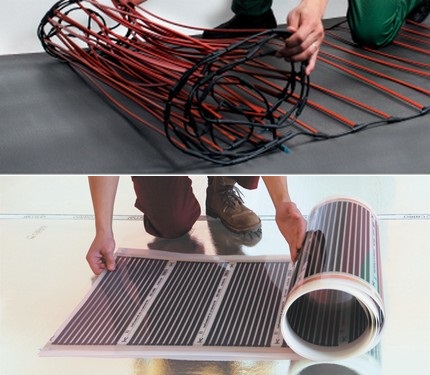
The film systems are made of strips of carbon paste - high-strength carbon fiber, which are hidden under a heat-resistant plastic film.
All strips, the thickness of which does not exceed ten millimeters, are located at an equidistant distance of 10-15 mm and are parallel connected by flat current-carrying busbars protected by a silver coating.
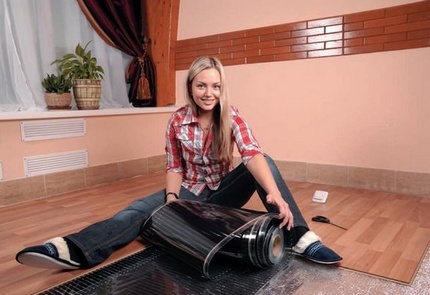
The core systems are graphite-silver rods, inside which carbon material is laid. They are interconnected by stranded wires and sealed in a protective copper sheath. Systems are available as individual cables or prefabricated bays.
Infrared rays in such systems act in a straightforward manner, and therefore cause heating not of ambient air, but of objects located indoors: flooring, furniture, walls and ceilings.Due to this property, the speed of infrared heating is much higher than traditional analogues - electric and water systems.
The indisputable advantages of infrared film warm floor include:
- Environmental friendliness. Infrared rays are similar in effect to sunlight and therefore have a beneficial effect on all living organisms. They have no side effect.
- Easy installation. The design features of the system make it possible to carry out high-quality installation at minimal cost and effort, owning only the basic skills of construction work.
- Compatibility with different types of coating. Laying of an infrared heat-insulated floor is allowed to be carried out immediately “on dry” under a carpet, parquet board, linoleum or laminate.
Due to the fact that the heating elements in the film system are densely laminated with a polymer layer, they are not afraid of accidental dents and punctures, as well as exposure to moisture. But even in case of damage to one of the carbon strips due to the parallel connection scheme, the remaining elements will continue to work.
The thickness of the thermal film does not reach 5 millimeters, and therefore practically does not “eat up” the height of the room. Thanks to this, it can safely be installed under almost any coating. In addition, such a film can be placed on vertical surfaces, fixing to the walls and ceiling, providing zone heating of the room.
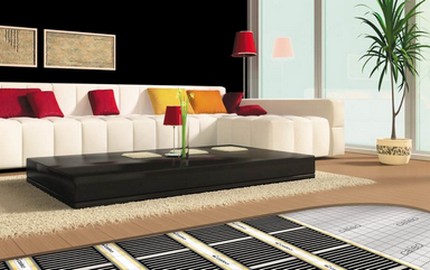
For this reason, film material is laid only in areas where large equipment and furniture will not stand. With caution, it is worth using IR systems in wet rooms, as there is a risk of electric shock.
The energy consumption for the operation of the infrared warm floor directly depends on the mode of operation of the system and the working area of the room. We also recommend that you familiarize yourself with our other articlewhere the film type of heating for rooms is described in detail.
The choice of system components
In addition to carbon heating strips sealed in mylar, the film floor system requires a temperature controller equipped with a temperature sensor.
Film Options
There are a lot of options for film floors in the modern market.And they all have approximately similar characteristics: power consumption from 25 to 80 W / h, and operating temperature from 30 to 50 ° C.
On sale you can find two types of film systems:
- solid - in them the film is completely covered with carbon material;
- striped - in them the carbon material is deposited on the surface in the form of strips 15-20 mm wide.
The difference between them is that in continuous systems the material is applied by rolling on the surface in the form of a paste, and in striped - by fragmentary spraying.
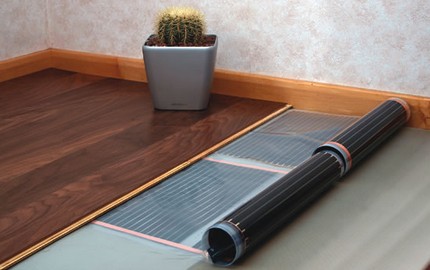
The thickness of the material can vary from two microns to 0.4 millimeters. The length of the roll is 50 meters.
There is an opinion that it is better to choose the thinnest films. But, as reviews show, the smaller the carbon layer, the faster the system crashes. Therefore, it is more advisable to purchase material no thinner than 3 mm. For example, for countries in Europe and the United States, the thickness of 0.338 mm is considered the best option.
Such systems are not cheap. The average price range of film IR systems from leading manufacturers varies between $ 20-25 per square meter. More details about the types of film underfloor heating can be found in this stuff.
Calculation of the required amount
Installation of a film floor with an infrared type of heating is carried out only according to the useful area of the room.
The percentage of the covered area depends on whether the IR system acts as the main or additional heat source:
- 80% of the area - as the main heating;
- 40-50% of the area - as an addition to radiator heating.
Determining the total length of all the strips will help the diagram of the layout of the zones of the system previously drawn on the sheet. After calculating the length of each fragment and adding up their number, it will not be difficult to calculate the necessary total length of the coating.
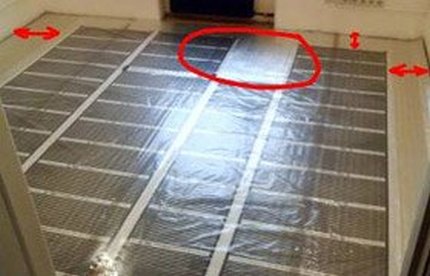
To prevent premature failure of the floor system, it is necessary to distance yourself from the pipes and risers of the central heating when laying out. The laid strips should not intersect and overlap each other.
When placing fragments on the plan and calculating their length, also take into account that the length of each strip should be a multiple of 17-18 centimeters, since cut lines are located in these places.
Thermostat for temperature control
The IR system is controlled by a temperature controller. The temperature sensor included in the package is placed between the heating elements, and is connected to the device through the contacts. The sensor reads the temperature from the surface of the film and transfers data to the thermostat, which, in turn, works and starts the system.
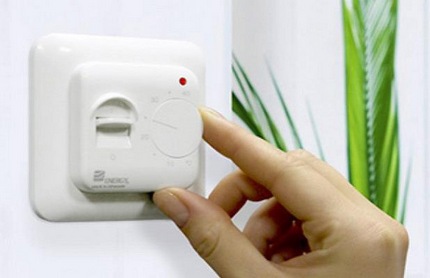
Variants of modifications of regulators, differing in functionality, a huge variety is presented on the market today.
All of them are conditionally divided into two types:
- Mechanical - equipped with keys and mechanical wheels and are suitable for arranging small-area systems.
- Electronic - equipped with push-button control and display, applicable for small non-zoned rooms.
Programmable models are equipped with touch screens, with which you can set 4 time modes at once, thereby saving up to 50% of energy consumption.
Temperature sensors, depending on the type of device and type of flooring, are available in two versions. For soft coatings, they are available in the form of compact plastic vessels.For solid - in the form of larger elements equipped with gel protection from exposure to strips of adhesive compositions and the prevention of mechanical damage.
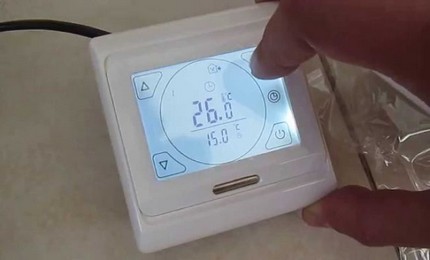
When choosing a device should focus on the power of the thermostat. It is calculated on the basis that one square meter of film on average consumes 50-70 watts. To determine the required value, the indicator is multiplied by the size of the working area, covered with heating elements.
Budget models that operate on the network often “sin” in that they cannot resume work on their own in the event of an emergency power outage. Therefore, it is better to give preference to models in which the battery is provided. And read more about choosing and installing a thermostat for a warm floor. Further.
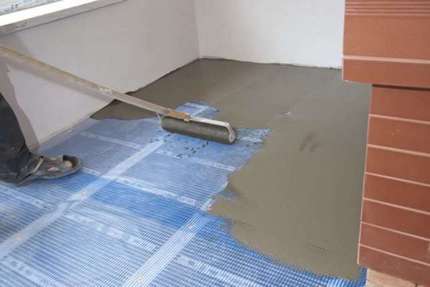
If the film system is supposed to be combined with a coating of porcelain stoneware or tile, a cement-sand screed will need to be built
Installation of infrared floor heating
Installing an IR system for a particular coating has its own characteristics. So, planning to use soft materials such as linoleum or carpet as a topcoat, sheets of fiberboard or plywood should be laid as a layer between the heating strips and it.
A rigid layer will protect the film from “injury” due to the punching of the cover with legs of heavy furniture or women's heels.
In any case, the installation of an infrared warm floor system is carried out in several stages.
Acquisition of materials and tools
In addition to the IR film itself, it is also necessary to purchase rolled thermal insulation material, as well as metallized, or one-sided construction tape for fixing it. The film itself is attached to the base using double-sided tape.
For work, you need a set of tools:
- a grinder equipped with a stone disc;
- hammer drill;
- knife or scissors;
- pliers or pliers;
- construction mixer;
- notched trowel;
- wide brush;
- container for mixing the solution.
If you have not already made a layout diagram at the stage of selecting the material, this must be done now, taking into account not only the size of the room, then the width of the stripes used.
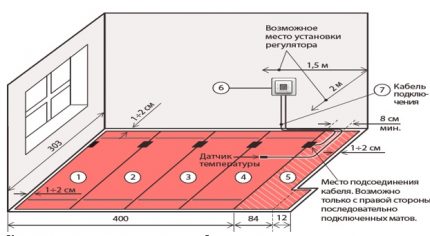
The arrangement of the films can be either longitudinal or transverse. The best option is to choose based on material savings. But still experts recommend placing stripes in length. This minimizes the number of connection points.
Base preparation
When preparing the base for laying the IR system, it is not at all necessary to dismantle the old coating. Dismantling will be required only if the base base is badly damaged and the surface is “strewn” with deep cracks and potholes.
According to the norms, the permissible height difference of the base base for the film system is only 0.2-0.3 cm per linear meter, regardless of the direction of the control rail attached to the surface or the construction level.
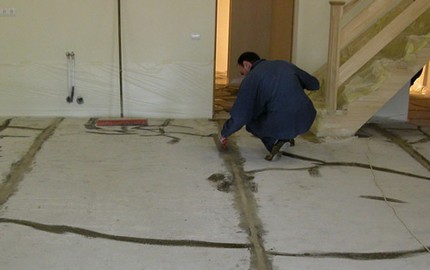
The technology of laying the IR system involves the arrangement of a heat-insulating layer, the main task of which is to prevent heat leakage through the floor slabs, thereby increasing the efficiency of the system.
As a heater, it is best suited:
- Isolon or Penofol- Roll insulation made of foamed polyethylene. They are distinguished by excellent waterproofing qualities, as in the process of foaming, closed, water-tight cells are formed;
- Cork backing - compressed particles of balsa wood mixed with suberin binder.
When installing underfloor heating, priority is given to substrates with a lavsan metallized or foil cladding. It enhances heat transfer due to its own reflective effect.
The structure of the listed materials will prevent the absorption of moisture, performing the function of a waterproofing, and the reflecting surface will direct the generated heat directly into the room, and not to the underlying floor.
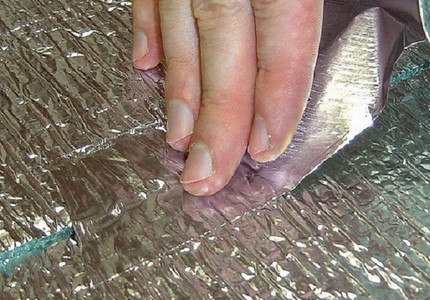
The substrate is spread over the entire area of the room close to the walls. The joints of the strips laid on the floor are fastened together with masking or aluminum tape. If the thickness of the material is small, you can also fasten the strips laid with a small overlap with construction brackets.
Laying the film system
In accordance with the marking, a film is cut into individual fragments, given that the maximum length of a single piece of cloth should not exceed eight meters. Cutting can be done with scissors or a knife. The cut fragments of the strips are sequentially laid out on a substrate according to the structured scheme.
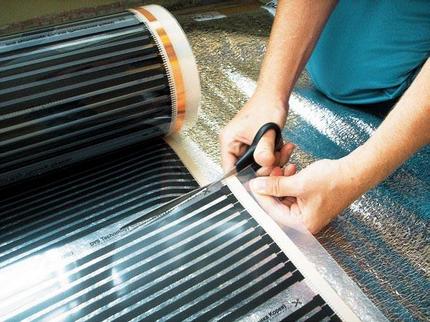
The film cuts are stacked face up or down in accordance with the manufacturer's instructions. Strictly according to the instructions, the IR system strips are placed. For example, Caleo film strip strips are laid with a lateral overlap so that there is a 1 cm gap between adjacent copper bars.
If the brands whose manufacturers are recommended to lay strips without overlap and with a more impressive distance between the tires. When laying, it is not allowed to bend carbon strips at an angle of 90 °, as this can damage a fragment of the system.
If necessary, the strips are cut along the perimeter of the room, making cuts in the areas strictly indicated by the dashed line on the film.Approximate dashed stripes for the cut are usually located every 18 cm.
To fix the film to the surface using double-sided tape. This solution allows you to prevent the shift of elements relative to the markup and each other. In the process of laying strips of infrared warm floors, it is important to prevent damage to the material, which often happens when the tools used during installation are accidentally dropped on them.
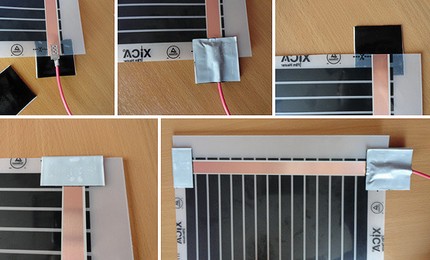
We also have other materials with a detailed description of the installation process of the film system, depending on the type of flooring. We recommend that you familiarize yourself with them.
- How to make a film underfloor heating under linoleum: instructions for laying an infrared heating system
- Laminate underfloor heating: installation and installation of a film infrared system
- How to make an electric heated floor for tiles: film and cable option
System Connection Diagram
Each strip is equipped with a copper clamp, which reliably connects to a conductor made of the same material. To connect the terminal, you will have to separate a section of 8-10 mm from the cut from the lamination, and carefully separate the silver and copper bus on the edge.
The contact is inserted strictly in the middle of the end of the conductive bus so that one of its sides is in contact with it, and the second is adjacent to the inner side of the film. The contacts are crimped with pliers, trying to prevent sparking.
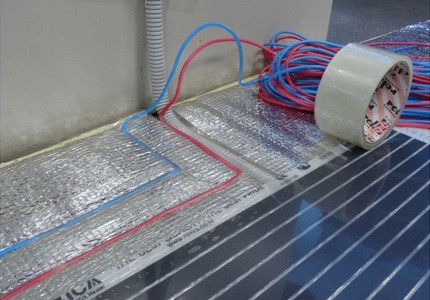
Lead wires with 10–12 millimeter “tails” of conductors stripped to the contact terminals are connected and connected: to one, “0”, to the other, “phase”. Connected terminals are gently clamped with pliers or pliers. If it is possible to apply soldering, the wires to the busbars can simply be soldered, and the joints should be sealed with insulation.
After connecting each piece of film, it is necessary to check the fixation of the clamp by pulling it slightly. It should not shift relative to the film.
The connection of the bands is performed using a parallel circuit. This means that wiring will only be done on one side. For "feeding" use stranded copper wires with a cross section of 1.5 square mm.
The joints of the clamp with the wires after crimping with pliers, as well as sections of the copper busbar cut on both sides, are necessarily isolated by cuts of vinyl-mastic tape, which is always included with the system.
At the free ends of the wires attached to all sections of the heating film, the resistance of the circuit is measured. Ideally, the calculated load should be 20% lower than that declared by the manufacturer of the selected thermostat model. If the received load corresponds to the maximum allowable indicator of the selected thermostat, proceed to its connection.
Mounting the control device
In order for the heat regulator to work correctly, the thermal sensor is fixed with adhesive tape on the underside of the heating sheet. Its installation is carried out using a 16 mm corrugated tube, which is included in the factory package.
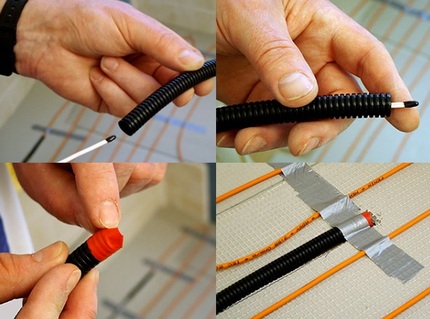
So that a tubercle does not form at the installation point of the temperature sensor, it is recommended to make shallow grooves in the base and heat-insulating layer. The location of the device is chosen as close as possible to the thermostat. The distance from the wall should be at least 30 cm.
There are no special requirements for the installation of a thermostat. It can be placed in any accessible place, hidden from direct sunlight. However, you should choose a place for its installation in advance, because it is better to lay the strips of the film system with the contacts to the wall on which the regulating device will be mounted. This method reduces the length of the connecting wires.
Mounting option can also be any:
- outer - in which the device is fixed directly to the wall surface;
- hidden - involves creating a recess in which the device will be hidden.
To perform flush mounting in the wall using a grinder or puncher, make strobes with a depth of 20 mm, into which the electrical wiring is laid.
The installation technology of the thermostat is not much different from the installation process of a conventional electrical outlet. To equip the "nest" in the wall with the help of a crown, make a niche into which the undergrowth is buried. Place the device at a height of 80-90 cm from the floor.
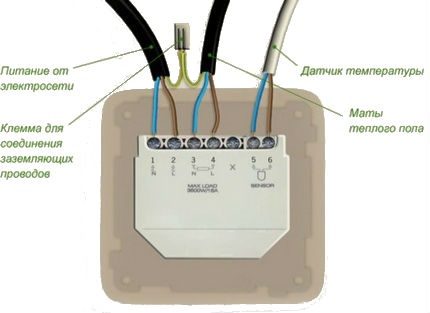
Having connected the temperature controller, it remains only to connect to the sensor terminals the free end of the temperature sensor laid in the corrugated pipe.
Test run IR system
After the installation and connection of the infrared warm floor is completed, it is necessary to check the operability of the system. Before starting, check the insulation of the connection points. First, the check is performed using a tester. The performance of the system should correspond to those specified by the manufacturer.
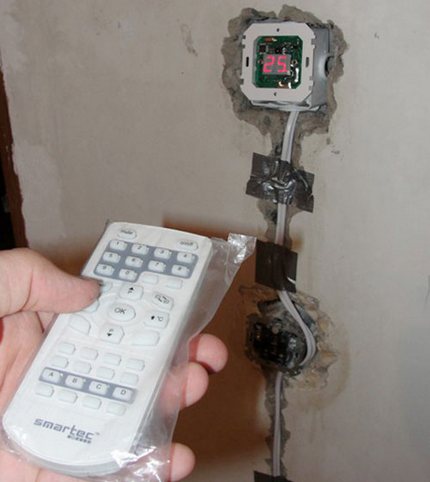
After starting the system, carefully check the uniformity of heating of each element. If problems are found on individual fragments, they are eliminated or replaced by segments of stripes with new ones.
If when the state is on, everything warms up evenly, and the contacts do not “smell” and do not spark, you can proceed to the stage of installation of the floor covering. It is better to save the IR system installation plan itself by attaching it to the product passport or by sketching on the back of the warranty documentation.
We also suggest that you familiarize yourself with our other material, which describes in detail the rules for installing and operating infrared warm floor.
Conclusions and useful video on the topic
Installation kit for laying the system:
Substrate construction and laying of heating strips:
Installation of the sensor and thermostat:
The film-type system is not complicated in execution. And therefore, even without the appropriate skills, installation can be done in just one day. The main thing is to strictly adhere to the styling technology. This will save you from an emergency and premature system failure.
Thinking about installing an infrared floor system, but don’t know where to start? Or do you have experience in installing such systems and can give practical advice for our readers? Please leave your comments, ask questions, share the experience of using the film floor system in the block below.

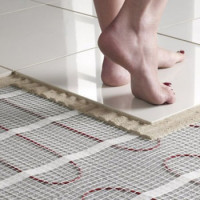 How to make a heated floor in the bathroom with your own hands: a step-by-step guide
How to make a heated floor in the bathroom with your own hands: a step-by-step guide  How to connect a warm floor with your own hands: the steps of connecting a water floor
How to connect a warm floor with your own hands: the steps of connecting a water floor 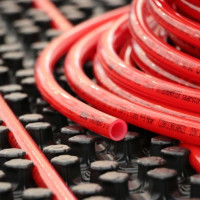 How to make a water-heated floor with your own hands: a step-by-step guide from design to assembly
How to make a water-heated floor with your own hands: a step-by-step guide from design to assembly 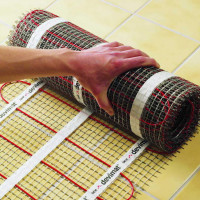 DIY electric underfloor heating: device, installation technology and wiring diagrams
DIY electric underfloor heating: device, installation technology and wiring diagrams 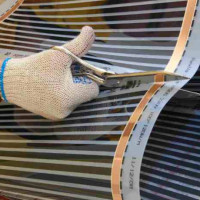 How to make a film underfloor heating under linoleum: instructions for laying an infrared heating system
How to make a film underfloor heating under linoleum: instructions for laying an infrared heating system 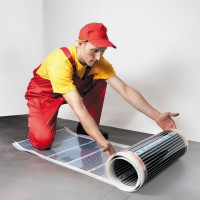 Infrared carbon warm floor: operating principle and laying rules
Infrared carbon warm floor: operating principle and laying rules  How much does it cost to connect gas to a private house: the price of organizing gas supply
How much does it cost to connect gas to a private house: the price of organizing gas supply  The best washing machines with dryer: model rating and customer tips
The best washing machines with dryer: model rating and customer tips  What is the color temperature of light and the nuances of choosing the temperature of the lamps to suit your needs
What is the color temperature of light and the nuances of choosing the temperature of the lamps to suit your needs  Replacement of a geyser in an apartment: replacement paperwork + basic norms and requirements
Replacement of a geyser in an apartment: replacement paperwork + basic norms and requirements
It’s possible, of course, to make such a warm floor with your own hands, but if only hands grow from the right place and there is at least rudimentary knowledge on electrical and installation of systems. The husband, too, at first set about the idea of constructing it with his own hand. I read everything I can, watched all the instructional videos, purchased material. And in the end, he said that he would not take responsibility, and hired installation masters. They quickly did everything.
To be honest, I’m concerned about the safety of infrared “warm floors”. Yes, it says about their environmental friendliness, but is it really so? Still, this is some kind, and the radiation ... We have small children, so I am seriously puzzled by the choice of type of warm floors. But still I look precisely in the direction of IR systems, because they heat up faster than water and electro, this is a huge plus.
Hello. Roughly speaking, infrared radiation is a way of transferring heat from a heated source to a colder one. The sun, radiators, the human body, and so on, as Alexander has already said, are all sources of infrared radiation.
The only thing it can be dangerous with is its intensity. That is, by how much energy it transfers. It is clear that if you stay for a long time under the scorching sun in extreme heat, you will overheat or even burn your body. To this state, you can bring any underfloor heating, radiators and so on, setting the wrong temperature range. A hot kettle on the stove is also dangerous if you put a burn on your hand. As a rule, tp т
On the other hand, the infrared floors receive energy from being supplied with electricity, which emits electromagnetic waves, the effect on the person of which is not yet fully understood. However, standards have been established that are absolutely safe for health, including in TP.
What really dangerous radiation is the radiation of a cell phone. Here is such a set of striking factors, which in the modern world they are trying to “forget”, hiding behind the wording “insufficiently studied”. Everything has been studied for a long time, when I did the diploma in the early 90s, I studied this topic, there was more than enough literature. My opinion, speak less on a cell phone and protect children from it.
Inna, infrared radiation is thermal radiation. Those. all heated surfaces emit in the infrared range including: kettle, human body, cast-iron battery, etc.